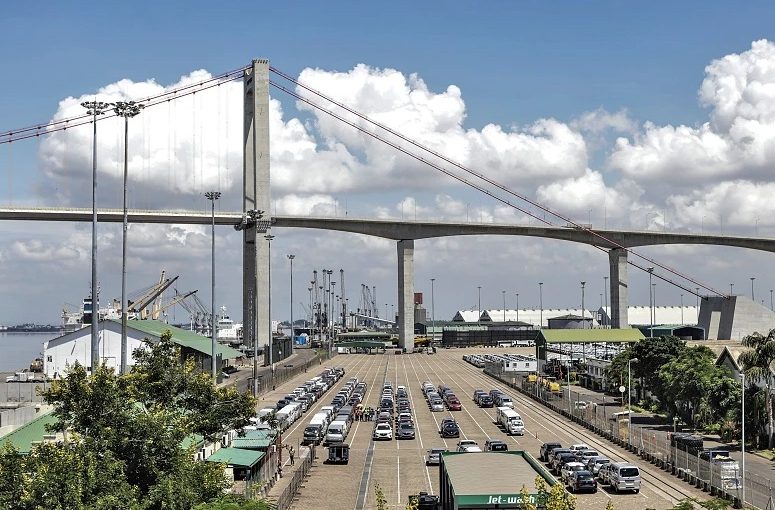Mozambique: Macia municipality allocates 300 mobile stalls - photos
Mozambique PMI at ten-month high in May – Standard Bank

File photo: Lusa
Key findings
- Output and new order growth ticks higher
- Strongest level of confidence since last October
- Inflationary pressures creep up
Business conditions at private sector companies in Mozambique improved at the fastest rate in ten months during May, as strengthening demand conditions led to quicker expansions in output and new orders. Jobs growth reaccelerated and there was a renewed rise in input purchasing, as firms grew more confident about the future and sought to boost capacity and productivity.
Input cost pressures reached their highest since July 2023, but remained mild when compared to historical levels. A faster rise in input costs drove an accelerated uptick in output prices.
The headline figure derived from the survey is the Purchasing Managers’ IndexTM (PMI®). Readings above 50.0 signal an improvement in business conditions on the previous month, while readings below 50.0 show a deterioration.
The headline PMI rose from 49.9 in April to 50.9 in May, printing above the 50.0 neutral mark and at its highest point since July 2023. The reading was consistent with a modest uplift in private sector business conditions.
All five sub-indices of the PMI provided positive directional influences in May. The two largest components, the output and new orders metrics, reached their highest levels in three months, as companies reported that stronger demand conditions led to faster upturns in sales and business activity. Expansions were recorded across most of the broad sectors covered by the survey, with agriculture being the only segment to see output and new orders fall.
Rising activity and demand levels led Mozambican companies to increase their staffing in May, driving a modest rise in employment. Like for output and sales, the rate of expansion quickened to the fastest since February. Some firms commented that higher workforce numbers enabled them to cut backlogs of work. Overall, outstanding business levels dropped for the third month running.
Mozambican firms also expanded their input purchases halfway through the second quarter, partly offsetting a fall in April. Higher
purchases reflected some efforts to rebuild inventories, which subsequently rose for the first time in eight months. Although firms benefitted from a shortening of delivery times, the rate of improvement eased to a six-month low.
On the price front, Mozambican firms saw a quickening of inflationary pressures in May, with all of the survey’s price metrics ticking higher from April. Faster increases in purchasing and staff costs were recorded, leading to the sharpest rate of input price inflation since July last year. That said, cost pressures were still broadly subdued when compared to historical standards.
In turn, companies raised their output charges at a quicker, but modest pace in May. The rate of prices charged inflation was the strongest registered since October 2023.
Finally, output expectations were fractionally higher in May, pushing the overall degree of confidence to the strongest in seven months. Positive output predictions were held by 47% of survey respondents, with anecdotal evidence pointing to hopes of higher demand, productivity gains and product development.
Comment
Fáusio Mussá, Chief Economist – Mozambique at Standard Bank commented:
“The Standard Bank Mozambique PMI rose to a seasonally adjusted level of 50.9 in May, a ten-month high, up from 49.9 in April, and printing above the 50 level for only the second time since September 2023. This reflects increases in output, new orders, employment, and stocks of purchases, which denotes improvements in aggregate demand.
“PMI prints above the 50-benchmark suggest month-onmonth growth in economic activity. The May PMI signals expansions across most of the sectors of economic activity, except for agriculture, which experienced a decline in output and new orders. Most likely agriculture performance remained constrained by adverse weather in some regions and limited financial support from the government.
“Persistent government domestic debt pressures and intermittent foreign exchange (FX) supply has seen the Banco de Moçambique (BOM) maintaining prudency in monetary policy easing. Despite the BOM cutting the MIMO policy rate by cumulative 225 basis points since the beginning of the year to the current level of 15%, in the context of low inflation, last reported at 3.3% in Apr, high real interest rates and high cash reserves ratios implies financing conditions remaining tight.
“Notably tight financing conditions saw credit to the economy contracting by 5.6% y/y in Mar. This, alongside limited FX supply, is subduing imports, which is critical to help rebalance the FX market. Balance of payments data for Q1:24 shows goods imports declining by 22.6% q/q or 2.5% y/y to USD2bn. However, during the same period, goods exports fell by 23.8% q/q to USD1.8bn, but sill rose 3.1% y/y. We retain our forecasts of GDP growth decelerating to 4.6% y/y this year and 3.8% in 2025, with year-end inflation at 5.9% y/y this year.”












Leave a Reply
Be the First to Comment!
You must be logged in to post a comment.
You must be logged in to post a comment.